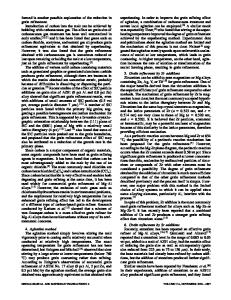Controlled Grain Refinement of Biodegradable Zn-Mg Alloy: The Effect of Magnesium Alloying and Multi-Pass Hydrostatic Ex
- PDF / 10,942,967 Bytes
- 13 Pages / 593.972 x 792 pts Page_size
- 115 Downloads / 233 Views
ON
BIODEGRADABLE metals are a new generation of materials which may be used in medical devices to improve patients’ lives significantly. They can be used for producing temporary implants, which will dissolve in a human body after completing their mission of supporting the healing process of damaged tissue.[1]
ANNA JARZE ˛ BSKA, MAGDALENA BIEDA, ŁUKASZ MAJ, ROBERT CHULIST, MARTYNA STRA ˛ G, and KRZYSZTOF SZTWIERTNIA are with the Institute of Metallurgy and Materials Science, Polish Academy of Sciences, 25 Reymonta St., 30-059, Krakow, Poland. Contact e-mail: [email protected] DANIEL WOJTAS is with the Institute of Metallurgy and Materials Science, Polish Academy of Sciences and also with the Faculty of Physics and Applied Computer Science, AGH University of Science and Technology, 30-059 Krakow, Poland. BARTOSZ SUŁKOWSKI is with the Faculty of Non-ferrous Metals, AGH University of Science and Technology, 30-059 Krakow, Poland. SYLWIA PRZYBYSZ and WACe´ AW PACHLA are with the Institute of High Pressure Physics, Polish Academy of Sciences, 01-142 Warsaw, Poland. WACŁAW PACHLA is with the Institute of High Pressure Physics, Polish Academy of Sciences. Manuscript submitted May 22, 2020; accepted September 15, 2020.
METALLURGICAL AND MATERIALS TRANSACTIONS A
Their degradation should proceed gradually with a harmless response from the host in regard to corrosive products. An example of an implant that does not require a long-term presence in a patient’s body is a stent. This small meshed tube used, among other things, in cardiovascular interventions supports artery walls and keeps the lumen open.[2] Specialized application needs a number of properties such as biocompatibility, a steady corrosion rate, and the appropriate combination of mechanical strength and plasticity.[3] Pure Zn fulfils most of the aforementioned requirements, which makes it a very promising material for biodegradable stents.[4–6] However, as-cast pure Zn has poor mechanical properties (i.e., yield strength, ultimate tensile strength, elongation to failure). Thus, it is of great importance to improve the strength and plasticity of pure Zn. Alloying is the most frequently applied method for strengthening biodegradable zinc, especially with elements such as magnesium, calcium or manganese.[7–9] Very promising results were obtained for hypoeutectic Zn alloyed with Mg, where even a small addition of Mg yielded a significant increase in the mechanical strength of the as-cast material.[10] Moreover, the addition of Mg is justified by its excellent biocompatibility. However,
alloying alone does not meet high criteria for application in biodegradable implants.[11] Therefore, it is often supported by methods of conventional plastic deformation, in particular hot rolling or hot extrusion.[12,13] A combination of these two methods yielded further improvement in strength, but failed to deliver simultaneous enhancement of all mechanical properties above a rigorous limit. Another solution lies in the use of unconventional methods of plastic deformation. The number
Data Loading...











